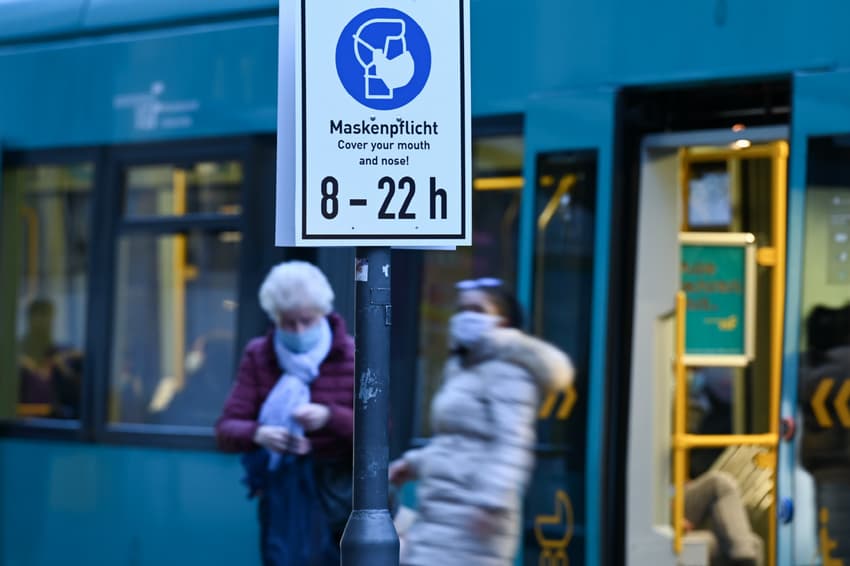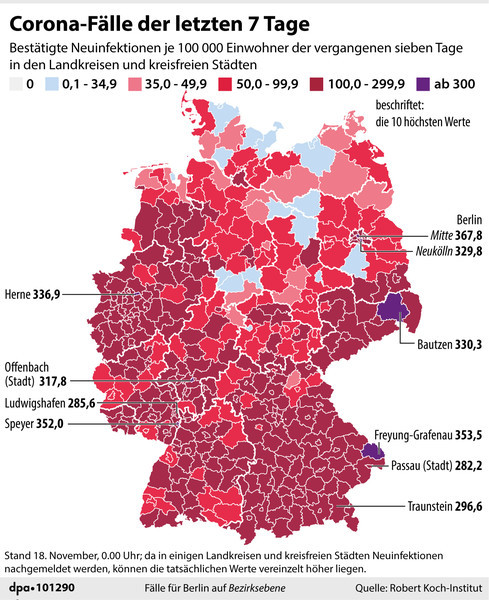EXPLAINED: Is the coronavirus situation in Germany improving?

How many active Covid-19 cases are there and what's the daily infection count? What about the intensive care bed situation? We take a look at the current picture.
Germany is currently in the middle of a partial shutdown aimed at stemming the spread of coronavirus. Is it working? Here's what you need to know about the situation this week.
1. Positive signs - but numbers still too high
On Thursday November 19th, the Robert Koch Institute (RKI) reported 22,609 new infections in 24 hours. RKI head Lothar Wieler said the numbers had "stabilised at a high level" but were still "too high".
On Wednesday the RKI reported a total of 17,561 new Covid-19 infections, almost 1,000 less than on Wednesday of the previous week (18,487). There was a peak last Friday when 23,542 infections were reported.
On Monday and Tuesday this week, new infections were also below the values of the previous week. However, it remains to be seen whether a decreasing trend will now be seen.
Chancellor Angela Merkel pointed out on Monday that Germany had managed to "break the dynamic of new infections" after restaurants, leisure facilities and cultural sites were ordered to close from the start of November.
"We still have a long way to go but the good news is that we have halted the exponential growth for now," Merkel said.
In total, 833,307 people have been infected with Sars-CoV-2 since the beginning of the pandemic in Germany.
READ ALSO:
-
'We still have a long way to go': Merkel fails in new curbs bid as Covid-19 infections stabilise
-
Covid-19 measures: What exactly did Merkel and state leaders agree?
2. What about deaths, recoveries and active cases?
A total of 13,370 people have died in connection with Covid-19 so far in Germany (as of November 19th).
The RKI said on Thursday 251 deaths were reported within the last 24 hours. Health experts say the number of deaths has been increasing since the beginning of September (and at a faster rate from October), likely because more older people have been contracting Covid-19.
According to the RKI around 562,700 people are considered to have recovered.
The number of active cases on Tuesday evening was 272,700 – that is about 800 less than the previous day when it was 273,600, according to the RKI situation report. This is an encouraging sign.
3. Which places in Germany are most affected?
According to the RKI, the 7-day incidence rate on Wednesday for Germany was 138.9, which was lower than the previous day (141.4).
Politicians and experts say they want to get that number down to an average of 50 coronavirus cases per 100,000 residents in seven days. At this level, health authorities can track and trace infection chains.
Coronavirus cases are currently highest in the places detailed on the DPA map below. The worst affected areas are coloured purple and dark red.
The highest value is in Berlin Mitte with an average of 367.8 cases per 100,000 residents in the last seven days. Berlin as a whole has a value of 214.1.

On Tuesday evening, 406 of the 412 regions in Germany covered by the RKI also showed an increased incidence of at least 25 cases per 100,000 inhabitants. Meanwhile, 20 districts are above the level of 250 cases per 100,000 inhabitants.
The states of Mecklenburg-Western Pomerania and Schleswig-Holstein are currently the least affected by the virus.
The graphic in the below tweet by Zeit Online gives an idea of how the coronavirus pandemic has progressed throughout the year.
A graphic from @Zeit showing the two Coronavirus waves spreading throughout Germany pic.twitter.com/kxfaCbpVK4
— James Jackson (@derJamesJackson) November 17, 2020
4. Reproductive number falling
The RKI reported the reproductive value or R number on Tuesday night as 1.0.
It has decreased compared to the previous day when it was 1.12. The 7-day R rate remains unchanged compared to the previous day and is still at 0.97.
The fact that both R-values have fallen to values around and below 1 is a good sign. It means that an infected person usually infects a maximum of one other person with Sars-CoV-2. However, experts want this number to be significantly lower. According to experts, an R value of 0.7 or lower would be ideal to get the infection situation under control.
5. What's the situation in intensive care units?
There are concerns about the rising number of Covid-19 patients.
According to the the German Interdisciplinary Association for Intensive and Emergency Medicine (DIVI) Register, 3,542 Covid-19 patients were in German intensive care units on Wednesday morning.
This is 24 more than on Tuesday morning (3,518). A total of 2,034 patients are using ventilators, the day before it was 2,011.
READ ALSO: How serious is the situation in Germany's hospitals?
The RKI said in its report that "the number of Covid-19 patients requiring intensive care has strongly increased, from 655 patients on October 15th to 3,517 patients on November 17th".
On October 26th 1,362 coronavirus patients were receiving medical treatment in ICU, with 46 percent receiving ventilation.
About two weeks later on the report for November 10th there were 3,127 registered coronavirus patients in intensive care, with around 56 percent receiving (1,737) ventilation.
A total of 21,935 of 28,347 intensive care beds in Germany are currently occupied. Meanwhile, 12,069 ICU beds can be made operational within seven days as emergency reserves.
Comments (1)
See Also
Germany is currently in the middle of a partial shutdown aimed at stemming the spread of coronavirus. Is it working? Here's what you need to know about the situation this week.
1. Positive signs - but numbers still too high
On Thursday November 19th, the Robert Koch Institute (RKI) reported 22,609 new infections in 24 hours. RKI head Lothar Wieler said the numbers had "stabilised at a high level" but were still "too high".
On Wednesday the RKI reported a total of 17,561 new Covid-19 infections, almost 1,000 less than on Wednesday of the previous week (18,487). There was a peak last Friday when 23,542 infections were reported.
On Monday and Tuesday this week, new infections were also below the values of the previous week. However, it remains to be seen whether a decreasing trend will now be seen.
Chancellor Angela Merkel pointed out on Monday that Germany had managed to "break the dynamic of new infections" after restaurants, leisure facilities and cultural sites were ordered to close from the start of November.
"We still have a long way to go but the good news is that we have halted the exponential growth for now," Merkel said.
In total, 833,307 people have been infected with Sars-CoV-2 since the beginning of the pandemic in Germany.
READ ALSO:
- 'We still have a long way to go': Merkel fails in new curbs bid as Covid-19 infections stabilise
- Covid-19 measures: What exactly did Merkel and state leaders agree?
2. What about deaths, recoveries and active cases?
A total of 13,370 people have died in connection with Covid-19 so far in Germany (as of November 19th).
The RKI said on Thursday 251 deaths were reported within the last 24 hours. Health experts say the number of deaths has been increasing since the beginning of September (and at a faster rate from October), likely because more older people have been contracting Covid-19.
According to the RKI around 562,700 people are considered to have recovered.
The number of active cases on Tuesday evening was 272,700 – that is about 800 less than the previous day when it was 273,600, according to the RKI situation report. This is an encouraging sign.
3. Which places in Germany are most affected?
According to the RKI, the 7-day incidence rate on Wednesday for Germany was 138.9, which was lower than the previous day (141.4).
Politicians and experts say they want to get that number down to an average of 50 coronavirus cases per 100,000 residents in seven days. At this level, health authorities can track and trace infection chains.
Coronavirus cases are currently highest in the places detailed on the DPA map below. The worst affected areas are coloured purple and dark red.
The highest value is in Berlin Mitte with an average of 367.8 cases per 100,000 residents in the last seven days. Berlin as a whole has a value of 214.1.

On Tuesday evening, 406 of the 412 regions in Germany covered by the RKI also showed an increased incidence of at least 25 cases per 100,000 inhabitants. Meanwhile, 20 districts are above the level of 250 cases per 100,000 inhabitants.
The states of Mecklenburg-Western Pomerania and Schleswig-Holstein are currently the least affected by the virus.
The graphic in the below tweet by Zeit Online gives an idea of how the coronavirus pandemic has progressed throughout the year.
A graphic from @Zeit showing the two Coronavirus waves spreading throughout Germany pic.twitter.com/kxfaCbpVK4
— James Jackson (@derJamesJackson) November 17, 2020
4. Reproductive number falling
The RKI reported the reproductive value or R number on Tuesday night as 1.0.
It has decreased compared to the previous day when it was 1.12. The 7-day R rate remains unchanged compared to the previous day and is still at 0.97.
The fact that both R-values have fallen to values around and below 1 is a good sign. It means that an infected person usually infects a maximum of one other person with Sars-CoV-2. However, experts want this number to be significantly lower. According to experts, an R value of 0.7 or lower would be ideal to get the infection situation under control.
5. What's the situation in intensive care units?
There are concerns about the rising number of Covid-19 patients.
According to the the German Interdisciplinary Association for Intensive and Emergency Medicine (DIVI) Register, 3,542 Covid-19 patients were in German intensive care units on Wednesday morning.
This is 24 more than on Tuesday morning (3,518). A total of 2,034 patients are using ventilators, the day before it was 2,011.
READ ALSO: How serious is the situation in Germany's hospitals?
The RKI said in its report that "the number of Covid-19 patients requiring intensive care has strongly increased, from 655 patients on October 15th to 3,517 patients on November 17th".
On October 26th 1,362 coronavirus patients were receiving medical treatment in ICU, with 46 percent receiving ventilation.
About two weeks later on the report for November 10th there were 3,127 registered coronavirus patients in intensive care, with around 56 percent receiving (1,737) ventilation.
A total of 21,935 of 28,347 intensive care beds in Germany are currently occupied. Meanwhile, 12,069 ICU beds can be made operational within seven days as emergency reserves.
Join the conversation in our comments section below. Share your own views and experience and if you have a question or suggestion for our journalists then email us at [email protected].
Please keep comments civil, constructive and on topic – and make sure to read our terms of use before getting involved.
Please log in here to leave a comment.